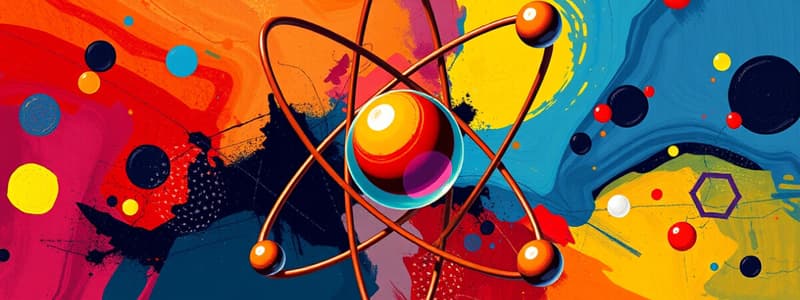Podcast
Questions and Answers
Which of the following is an example of a compound?
Which of the following is an example of a compound?
- Hydrogen
- Air
- Sodium chloride (correct)
- Salad
What is the main characteristic of ionic bonds?
What is the main characteristic of ionic bonds?
- They occur only between metal atoms.
- They result in both atoms retaining their original charge.
- They are formed through the transfer of electrons. (correct)
- They involve the sharing of electrons.
What defines the atomic number of an element?
What defines the atomic number of an element?
- The total mass of the atom.
- The number of neutrons in the atom.
- The number of protons in the atom. (correct)
- The total number of protons and neutrons.
Which process represents a decomposition reaction?
Which process represents a decomposition reaction?
Which state of matter has a definite shape and volume?
Which state of matter has a definite shape and volume?
What characterizes acids on the pH scale?
What characterizes acids on the pH scale?
Which of the following best describes a solvent?
Which of the following best describes a solvent?
What measurement describes the concentration of a solution?
What measurement describes the concentration of a solution?
What distinguishes alkenes from alkanes?
What distinguishes alkenes from alkanes?
Which of the following best describes metalloids?
Which of the following best describes metalloids?
What is the role of a limiting reactant in a chemical reaction?
What is the role of a limiting reactant in a chemical reaction?
Which of the following best characterizes exothermic reactions?
Which of the following best characterizes exothermic reactions?
What is the significance of balanced chemical equations?
What is the significance of balanced chemical equations?
Flashcards are hidden until you start studying
Study Notes
Basic Concepts of Chemistry
- Matter: Anything that has mass and takes up space. Divided into:
- Elements: Pure substances that cannot be broken down (e.g., hydrogen, oxygen).
- Compounds: Substances formed from two or more elements chemically bonded (e.g., water, sodium chloride).
- Mixtures: Physical combinations of substances that retain their individual properties (e.g., air, salad).
Atomic Structure
- Atoms: Basic unit of matter, consisting of:
- Protons: Positively charged particles in the nucleus.
- Neutrons: Neutral particles in the nucleus.
- Electrons: Negatively charged particles orbiting the nucleus.
- Atomic Number: Number of protons in an atom, defining the element.
- Mass Number: Total number of protons and neutrons in the nucleus.
Chemical Bonds
- Ionic Bonds: Formed through the transfer of electrons from one atom to another, resulting in charged ions (e.g., NaCl).
- Covalent Bonds: Formed when two atoms share one or more pairs of electrons (e.g., H2O).
- Metallic Bonds: Attraction between metal atoms and delocalized electrons, allowing for conductivity and malleability.
Chemical Reactions
- Reactants: Substances that undergo change in a chemical reaction.
- Products: New substances formed as a result of the chemical reaction.
- Types of Reactions:
- Synthesis: A + B → AB
- Decomposition: AB → A + B
- Single Replacement: A + BC → AC + B
- Double Replacement: AB + CD → AD + CB
- Combustion: Hydrocarbon + O2 → CO2 + H2O
States of Matter
- Solids: Definite shape and volume; particles are tightly packed.
- Liquids: Definite volume but no definite shape; particles are close but can move.
- Gases: No definite shape or volume; particles are far apart and move freely.
- Plasma: Ionized gas with free electrons; found in stars.
Solutions and Concentrations
- Solvent: Substance that dissolves the solute (e.g., water).
- Solute: Substance that is dissolved (e.g., salt).
- Concentration: Amount of solute in a given volume of solvent (e.g., molarity).
Acids and Bases
- Acids: Substances that donate protons (H+) in solutions; have a pH less than 7 (e.g., HCl).
- Bases: Substances that accept protons; have a pH greater than 7 (e.g., NaOH).
- pH Scale: Measures acidity or basicity on a scale from 0 to 14.
Periodic Table
- Groups: Vertical columns with similar chemical properties (e.g., alkali metals, halogens).
- Periods: Horizontal rows indicating energy levels of electrons.
- Metals: Good conductors, malleable, ductile; found on the left side.
- Nonmetals: Poor conductors, brittle; found on the right side.
- Metalloids: Properties intermediate between metals and nonmetals (e.g., silicon).
Stoichiometry
- Mole: Unit for counting particles, equivalent to Avogadro's number (6.022 x 10²³).
- Balanced Equations: Conservation of mass requires equations to be balanced for atoms on both sides.
- Limiting Reactant: The reactant that is completely consumed first, limiting the amount of product formed.
Thermochemistry
- Exothermic Reactions: Release energy (heat) to the surroundings (e.g., combustion).
- Endothermic Reactions: Absorb energy from the surroundings (e.g., photosynthesis).
Organic Chemistry
- Hydrocarbons: Compounds consisting only of hydrogen and carbon.
- Alkanes: Single bonds (e.g., methane).
- Alkenes: At least one double bond (e.g., ethylene).
- Alkynes: At least one triple bond (e.g., acetylene).
- Functional Groups: Specific groups of atoms that determine the characteristics of organic compounds (e.g., -OH for alcohols, -COOH for carboxylic acids).
Basic Concepts of Chemistry
- Matter is defined as anything with mass that occupies space.
- Elements are pure substances that cannot be simplified, such as hydrogen and oxygen.
- Compounds consist of two or more elements chemically bonded, like water and sodium chloride.
- Mixtures are physical blends of substances that maintain their individual characteristics, e.g., air and salad.
Atomic Structure
- Atoms are the fundamental units of matter, containing protons, neutrons, and electrons.
- Protons are positively charged particles located in the nucleus.
- Neutrons are neutral particles also found in the nucleus.
- Electrons are negatively charged and orbit around the nucleus.
- The atomic number represents the number of protons in an atom, identifying the specific element.
- The mass number indicates the sum of protons and neutrons in the nucleus.
Chemical Bonds
- Ionic bonds form through the transfer of electrons, creating charged ions, exemplified by sodium chloride (NaCl).
- Covalent bonds involve the sharing of electron pairs between atoms, as seen in water (H2O).
- Metallic bonds occur due to attraction between metal atoms and delocalized electrons, granting properties like conductivity and malleability.
Chemical Reactions
- Reactants are the substances that initiate a chemical reaction, while products are the newly formed substances.
- Types of chemical reactions include:
- Synthesis: Combining elements to form a compound (A + B → AB).
- Decomposition: Breaking down a compound into its elements (AB → A + B).
- Single Replacement: One element replaces another in a compound (A + BC → AC + B).
- Double Replacement: Exchange of components between two compounds (AB + CD → AD + CB).
- Combustion: Reaction of hydrocarbons with oxygen, producing carbon dioxide and water (Hydrocarbon + O2 → CO2 + H2O).
States of Matter
- Solids have a fixed shape and volume with densely packed particles.
- Liquids possess a defined volume but take the shape of their container, with particles that can move relative to each other.
- Gases lack a fixed shape or volume, featuring widely spaced particles that move freely.
- Plasma is an ionized state of matter, consisting of free electrons, commonly found in stars.
Solutions and Concentrations
- Solvents are substances that dissolve solutes; water is a common example.
- Solutes are substances that dissolve in the solvent, such as salt.
- Concentration refers to the quantity of solute present in a specific volume of solvent, commonly expressed in molarity.
Acids and Bases
- Acids release protons (H+) in solutions and have a pH of less than 7, like hydrochloric acid (HCl).
- Bases accept protons and have a pH greater than 7, such as sodium hydroxide (NaOH).
- The pH scale measures the acidity or basicity, ranging from 0 (acidic) to 14 (basic).
Periodic Table
- Groups are vertical columns containing elements with similar properties, including alkali metals and halogens.
- Periods are horizontal rows that indicate the energy levels of electrons within the elements.
- Metals, known for conductivity and malleability, are predominantly located on the left side of the table.
- Nonmetals, which are generally poor conductors and brittle, are found on the right side.
- Metalloids possess mixed properties, occupying a position between metals and nonmetals, e.g., silicon.
Stoichiometry
- The mole is a fundamental unit for counting particles, equivalent to approximately 6.022 x 10²³ entities (Avogadro's number).
- Balanced chemical equations reflect the principle of mass conservation, ensuring equal atom counts on both sides.
- The limiting reactant is the reactant that gets entirely consumed first, thus restricting the maximum yield of products.
Thermochemistry
- Exothermic reactions release heat energy into the surroundings; combustion is a classic example.
- Endothermic reactions absorb heat energy from their surroundings, as observed in photosynthesis.
Organic Chemistry
- Hydrocarbons are organic molecules composed solely of carbon and hydrogen.
- Alkanes contain only single bonds, e.g., methane.
- Alkenes feature at least one double bond, such as ethylene.
- Alkynes contain at least one triple bond, like acetylene.
- Functional groups are specific atoms or groups that define the behavior and categorization of organic compounds, e.g., -OH denotes alcohols, and -COOH indicates carboxylic acids.
Studying That Suits You
Use AI to generate personalized quizzes and flashcards to suit your learning preferences.




